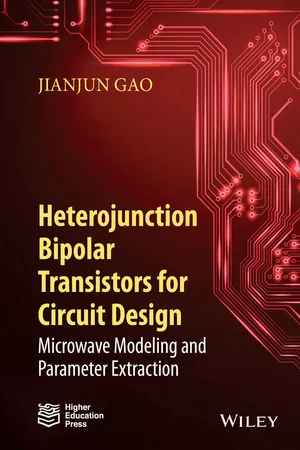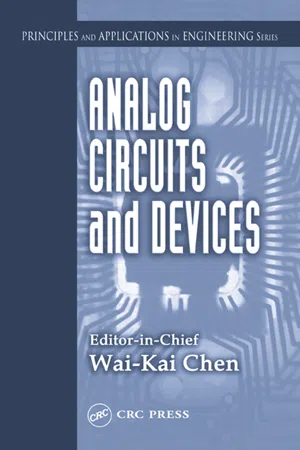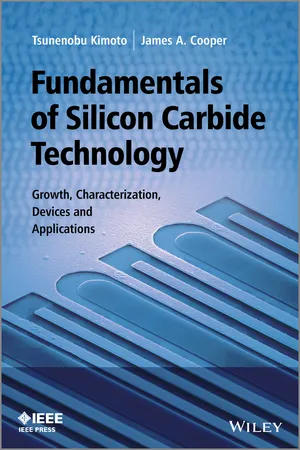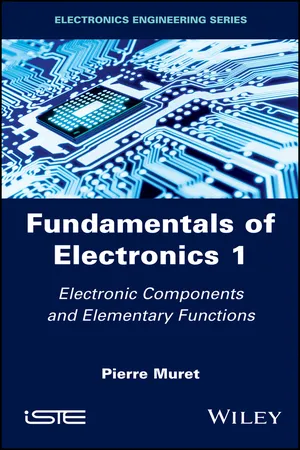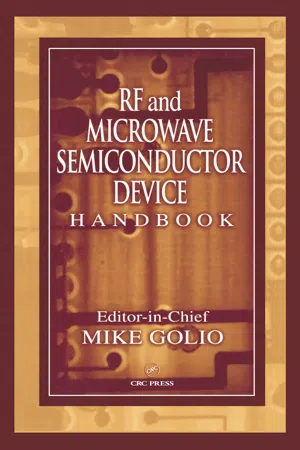Physics
Bipolar Junction Transistor
A bipolar junction transistor (BJT) is a three-terminal semiconductor device used for amplification and switching of electronic signals. It consists of three regions of doped semiconductor material: the emitter, base, and collector. By controlling the flow of charge carriers between these regions, the BJT can amplify small signals or act as a switch in electronic circuits.
Written by Perlego with AI-assistance
Related key terms
8 Key excerpts on "Bipolar Junction Transistor"
- eBook - ePub
Heterojunction Bipolar Transistors for Circuit Design
Microwave Modeling and Parameter Extraction
- Jianjun Gao(Author)
- 2015(Publication Date)
- Wiley(Publisher)
3 Modeling and Parameter Extraction Methods of Bipolar Junction Transistor The innovation of Bipolar Junction Transistor (BJT) in 1947 at the Bell Telephone Laboratories ushered in the era of solid-state circuit for amplifying voice signals. Transistor is defined as a nonlinear three-terminal, active semiconductor device, where the flow of electrical current between two of the terminals is controlled by the third terminal. A transistor is a three-terminal semiconductor device that can perform two functions that are fundamental to the design of electronic circuits: amplification and switching. The term transistor was coined as a portmanteau of the term “transfer” and “resistor.” The innovators of the bipolar transistor, William Shockley, John Bardeen, and Walter Brattain, were honored with the 1956 Nobel Prize in Physics “for their researches on semiconductors and their discovery of the transistor effect,” initially developed as a point-contact single device in germanium. Work at Texas Instruments led to the first silicon bipolar transistor and later to the first integrated circuit. The transistor has proliferated into a wide host of sophisticated types ranging from the still popular BJT over the modern FET devices. Although the MOSFET are the most widely used electronic device and CMOS process is main stream in microwave and RF circuit designs, the BJT devices continue to play a key role in microelectronics due to its low-cost construction, relatively high operating frequency, low-noise performance, and high power-handling capacity. The BJTs can be combined with MOSFETs to create innovative circuits that take advantage of the high input impedance and low power operation of MOSFETs and the very high-frequency operation and high-current driving capability of BJTs - eBook - ePub
- Wai-Kai Chen(Author)
- 2003(Publication Date)
- CRC Press(Publisher)
1Bipolar Junction Transistor (BJT) Circuits
David J.Comer Donald T.Comer Brigham Young University
1.1 Introduction
The Bipolar Junction Transistor (or BJT) was the workhorse of the electronics industry from the 1950s through the 1990s. This device was responsible for enabling the computer age as well as the modern era of communications. Although early systems that demonstrated the feasibility of electronic computers used the vacuum tube, the element was too unreliable for dependable, long-lasting computers. The invention of the BJT in 19471 and the rapid improvement in this device led to the development of highly reliable electronic computers and modern communication systems.Integrated circuits, based on the BJT, became commercially available in the mid- 1960s and further improved the dependability of the computer and other electronic systems while reducing the size and cost of the overall system. Ultimately, the microprocessor chip was developed in the early 1970s and the age of small, capable, personal computers was ushered in. While the metal-oxide-semiconductor (or MOS) device is now more prominent than the BJT in the personal computer arena, the BJT is still important in larger high-speed computers. This device also continues to be important in communication systems and power control systems.Because of the continued improvement in BJT performance and the development of the heterojunction BJT, this device remains very important in the electronics field, even as the MOS device becomes more significant.1.2 Physical Characteristics and Properties of the BJT
Although present BJT technology is used to make both discrete component devices as well as integrated circuit chips, the basic construction techniques are similar in both cases, with primary differences arising in size and packaging. The following description is provided for the BJT constructed as integrated circuit devices on a silicon substrate. These devices are referred to as “junction-isolated” devices. - eBook - ePub
- Jerry C. Whitaker(Author)
- 2017(Publication Date)
- CRC Press(Publisher)
9Bipolar Junction and Junction Field-Effect Transistors Sidney Soclof California State University, Los Angeles9.1 Bipolar Junction Transistors 9.2 Amplifier Configurations 9.3 Junction Field-Effect Transistors JFET as an Amplifier: Small-Signal AC Voltage Gain JFET as a Constant Current Source Operation of a JFET as a Voltage-Variable Resistor Voltage-Variable Resistor Applications9.1 Bipolar Junction Transistors
A basic diagram of the Bipolar Junction Transistor (BJT) is shown in Fig. 9.1 . Whereas the diode has one PN junction, the BJT has two PN junctions. The three regions of the BJT are the emitter, base, and collector. The middle, or base region, is very thin, generally less than 1 μm wide. This middle electrode, or base, can be considered to be the control electrode that controls the current flow through the device between emitter and collector. A small voltage applied to the base (i.e., between base and emitter) can produce a large change in the current flow through the BJT.BJTs are often used for the amplification of electrical signals. In these applications the emitter-base PN junction is turned on (forward biased) and the collector-base PN junction is off (reverse biased). For the NPN BJT as shown in Fig. 9.1 , the emitter will emit electrons into the base region. Since the P-type base region is so thin, most of these electrons will survive the trip across the base and reach the collector-base junction. When the electrons reach the collector-base junction they will roll downhill into the collector, and thus be collected by the collector to become the collector currentIC. The emitter and collector currents will be approximately equal, soIC≅IE. There will be a small base current,IB, resulting from the emission of holes from the base across the emitter-base junction into the emitter. There will also be a small component of the base current due to the recombination of electrons and holes in the base. The ratio of collector current to base current is given by the parameter β orhFE, is β =IC /IB - eBook - ePub
Fundamentals of Silicon Carbide Technology
Growth, Characterization, Devices and Applications
- Tsunenobu Kimoto, James A. Cooper(Authors)
- 2014(Publication Date)
- Wiley-IEEE Press(Publisher)
Chapter 9 Bipolar Power Switching Devices9.1 Bipolar Junction Transistors (BJTs)
Bipolar transistors were the first power transistors developed in silicon, but they have now been largely displaced by silicon insulated-gate bipolar transistors (IGBTs) and thyristors. This occurred because silicon Bipolar Junction Transistors (BJTs) suffer from a phenomenon known as “second breakdown” that limits the safe operating area (SOA) of the device. As will be shown below, the higher critical field for avalanche breakdown in SiC essentially eliminates second breakdown, making high-performance power BJTs practical. BJTs are particularly attractive for high-temperature applications, since they are not dependent on a gate oxide for their operation, and are not subject to the oxide reliability limitations of metal-oxide-semiconductor field effect transistors (MOSFETs) and IGBTs.As is our custom when considering a new device, we begin our discussion with a review of the basics of BJT operation. We then consider a number of special effects that occur during high-current operation of power BJTs. Figure 9.1 shows a basic BJT, along with standard current and voltage definitions. In these devices the emitter is more heavily doped than the base, and the base is more heavily doped than the collector, so . We can identify four internal junction currents, the hole and electron currents crossing the emitter–base (EB) junction and the hole and electron currents crossing the collector–base (CB) junction . The polarities in the figure correspond to positive current flow, and we should remember that electron flux is opposite to direction of electron current. Voltages and are developed across the junction depletion regions, shown cross-hatched in the figure. The widths of the emitter, base, and collector, measured from the metallurgical junctions, are , and , and the width of the neutral portion of the base, measured between the edges of the depletion regions, is simply - eBook - ePub
Electronics
from Classical to Quantum
- Michael Olorunfunmi Kolawole(Author)
- 2020(Publication Date)
- CRC Press(Publisher)
3 Structure of Bipolar Junction TransistorIn this chapter we present the structure of the bipolar transistor and show how a three-layer structure with alternating n -type and p -type regions can provide current and voltage amplification. We then present the ideal transistor model and derive an expression for the current gain in the forward-active mode of operation, as well as quantifying the operating point stability. We discuss how to model for small and large signals leading to simpler analysis of the circuits.Transistors are the most crucial elements in modern electronics. Transistors are used in a great variety of circuits and remain important devices for ultra-high-speed discrete logic circuits such as emitter coupled logic, power-switching applications (including modern electronic digital computers), and in microwave power amplifiers. Transistors, as amplifiers, are used to amplify an electrical signal by allowing a small current or voltage to control the flow of a much larger current from a direct current (dc) power source. An example of transistor usage is in audio systems. There are two general types of transistors: bipolar and field effect. Very roughly, the difference between these two types is that for bipolar devices an input current controls the large current flow through the device, while for field-effect transistors (FET) an input voltage provides the control. In most practical applications, an operational amplifier (abbreviated as op-amp ) is often used as a source of gain or amplification rather than to build an amplifier from discrete transistors. But there is a compelling case to having a good understanding of transistor fundamentals. For instance, the integrated circuits (ICs or chips) used in most computers are made from transistors (as well as diodes and other passive devices—transistors and capacitors), and so the behavior of logic devices depends upon the behavior of transistors. Also, given that op-amps are built from transistors, a detailed understanding of op-amp behavior, particularly input and output characteristics, must be based on an understanding of transistors. Op-amps are discussed in Chapter 4 - eBook - ePub
Fundamentals of Electronics 1
Electronic Components and Elementary Functions
- Pierre Muret(Author)
- 2017(Publication Date)
- Wiley-ISTE(Publisher)
2 Bipolar Junction Transistors and Applications2.1. The transistor effect
By the 1950s, the transistor effect had inspired the first semiconductor-controlled devices in which one electrode regulates the current flowing between two others. The effect relies on the injection of minority carriers into an electrode, called the “base”, from the “emitter” electrode of the opposite type, in which the charge carriers are majority carriers. The third electrode, or the “collector”, of the same type as the emitter, collects less current than that issued by the emitter but is dependent on the potential difference between base and emitter and on the emitter current. Let us consider the example of the pnp type, in which the base is p type. Historically, the term “base” was used due to the central position of this semiconductive part, which was originally used to diffuse doping impurities of the opposite type in order to create the emitter and collector on either side. Subsequent developments in semiconductor technology led to the production of Bipolar Junction Transistors with architecture better matched to the regimes that favor the transistor effect, foremost of which were the control of base thickness and concentration of doping impurities in the collector. Indeed, base thickness affects the transistor effect by determining the percentage of emitter current that reaches the base–collector junction. The main factor affecting this current gain below 1 is due to the recombination of minority carriers in the base before they reach the depletion zone at the base–collector junction where they are aspirated by the electric field. We will consider another factor in this section covering the various types of current but, as a first approximation, if we model the bipolar pnp transistor on a single axis Ox as in the case of a pn diode, it can be represented in Figure 2.1 - eBook - ePub
- Mike Golio(Author)
- 2017(Publication Date)
- CRC Press(Publisher)
Within a few years of the discovery of the transistor, its theory of operation was developed and refined. The decade of the 1950s was a race toward the development of a practical technique to fabricate them. Research into various aspects of the material sciences led to the development of the planar process with silicon as the cornerstone element. Substrate and epitaxial growth, dopant diffusion, ion-implantation, metalization, lithography, and oxidation had to be perfected and integrated into a manufacturable process flow. These efforts culminated with Robert Noyce’s patent application for the planar silicon BJT IC concept that he invented while at Fairchild. In the 1960s, the first commercial ICs appeared on the market, launching the modern age of electronics. Since then, transistor performance and integration levels have skyrocketed driven primarily by advances in materials, metrology, and process technology as well as competition, cost, and opportunity.4.2 Basic Operation
The basic structure of the bipolar transistor given in Fig. 4.1a consists of two back-to-back intimately coupled p-n junctions. While the npn transistor will be chosen as the example, note that the pnp structure operates identically, albeit in complementary fashion. Bipolar transistor action is based on the injection of minority carrier electrons from the emitter into the base as dictated by the base-emitter voltage. These carriers diffuse across the thin base region and are swept by the collector, which is normally reverse biased. In high speed ICs, BJTs are nearly always biased in this way, which is known as the forward active mode. The net effect is that an input signal voltage presented across the base-emitter terminals causes a current to flow into the collector terminal. The relationship between collector current, Ic , and base-emitter voltage, Vbe , originates from fundamental thermodynamic arguments via the statistical Boltzmann distribution of electrons and holes in solids. It is given by,(4.1)I c=I sexp (V/b eV t)where Is is called the saturation current and Vt is Boltzmann’s thermal voltage kT/q, which is 26 mV at room temperature (RT). This expression plotted in Fig. 4.1b is valid over many decades of current and its implications are far reaching in BJT IC design. Consider the small-signal transfer characteristics relating the output current to input voltage at a given bias current, Ic , i.e., the transconductance, gm - Earl Boysen, Harry Kybett(Authors)
- 2012(Publication Date)
- Wiley(Publisher)
Chapter 3 Introduction to the Transistor The transistor is undoubtedly the most important modern electronic component because it has enabled great and profound changes in electronics and in your daily lives since its discovery in 1948.This chapter introduces the transistor as an electronic component that acts similarly to a simple mechanical switch, and it is actually used as a switch in many modern electronic devices. A transistor can be made to conduct or not conduct an electric current—exactly what a mechanical switch does.Most transistors used in electronic circuits are Bipolar Junction Transistors (BJTs), commonly referred to as bipolar transistors junction field effect transistors (JFETs) or metal oxide silicon field effect transistors (MOSFETs). This chapter (along with Chapter 4, “The Transistor Switch,” and Chapter 8, “Transistor Amplifiers”) illustrates how BJTs and JFETs function and how they are used in electronic circuits. Because JFETs and MOSFETs function in similar fashion, MOSFETs are not covered here.Projects in this chapter can help you to build a simple one-transistor circuit. You can easily set up this circuit on a home workbench. You should take the time to obtain the few components required, and actually build and operate the circuit.In Chapter 4, you continue to study transistor circuits and the operation of the transistor as a switch. In Chapter 8, you learn how a transistor can be made to operate as an amplifier. In this mode, the transistor produces an output that is a magnified version of an input signal, which is useful because many electronic signals require amplification. These chapters taken together present an easy introduction to how transistors function, and how they are used in basic electronic circuits.
Learn about this page
Index pages curate the most relevant extracts from our library of academic textbooks. They’ve been created using an in-house natural language model (NLM), each adding context and meaning to key research topics.
